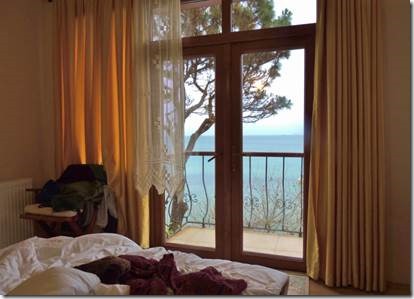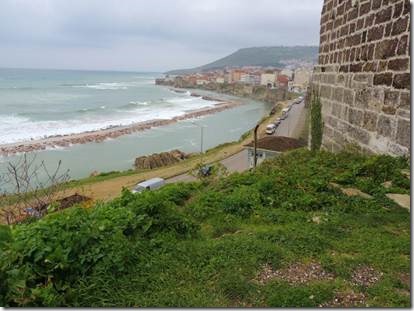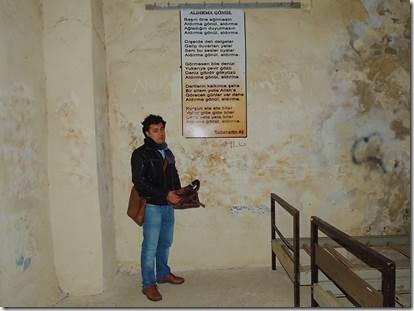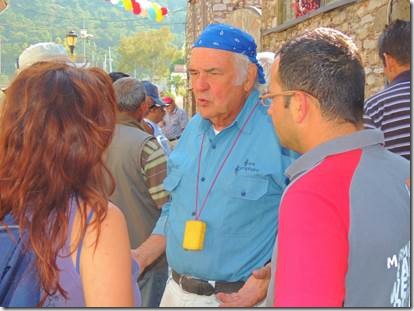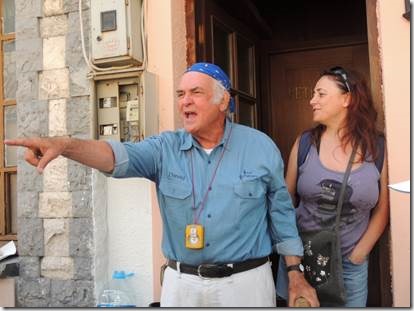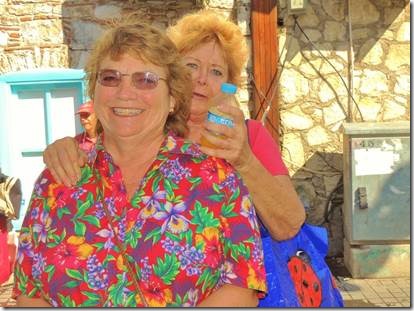Merhaba,
It seems like forever ago that we were in Sinop wearing hats and scarves, sweaters and rain gear. We only really had one day. If I had the chance to go back, I would.
Ru
Sinop in the news, rather than in the ancient past…..
Japan signs deal with Turkey to build nuclear plant By Laura Smith-Spark, CNN
May 4, 2013 — Updated 1104 GMT (1904 HKT)
STORY HIGHLIGHTS
Japan and Turkey agree a $22 billion contract for a nuclear reactor
The reactor will be built in Turkey’s northern Sinop province, on the Black Sea
Turkey’s prime minister says technology has advanced since Japan’s Fukushima disaster
Turkey, like Japan, is in an active earthquake zone
My favorites about Sinop? Lunch, the light house on the northernmost tip, and just the fun of walking around town. The weather really didn’t cooperate at all; it was drizzle and damp and that put the kibosh on the coastal cruise some folks planned to do. It meant putting layers of clothes on and layers off, but our hotel room was nice and warm, and the drizzle could have been a heavy rain. So, one really can’t complain.
http://www.turkishairlines.com is a great article to read if you’re planning to visit.
|
Our lovely little room at the Sinop Antique Place Hotel had a balcony overlooking the Black Sea. The first night I could leave the doors open for the breeze. The second night there was too much wind and several bright lights from the huge cargo ships out at anchor. |
||
|
Kumkapi ( Sand Gate) “Sinop has been fortified since 2,000 BC, but the existing walls are developments of those originally erected in 72 BC by King Mithridates VI.” Lonely Planet Turkey Guide |
||
|
It was far too damp and windy to walk the ramparts, but we did brave the elements to take some photos of the sea behind. Looking right towards the city center Looking left |
||
|
Sinop was the birth place of Diogenes the Cynic: this statue is in front of the fortification. Diogenes, as the story goes, moved to Athens where the promise of lodging fell through so he lived in a huge ceramic tub! The lower part of the monument depicts Diogenes in his tub which looks like a huge ceramic urn. “When Plato is asked what sort of man Diogenes is, he responds, “A Socrates gone mad” (Diogenes Laertius, Book 6, Chapter 54).” http://www.iep.utm.edu/diogsino/ “Alexander the Great was reported to have said, "Had I not been Alexander, I should have liked to be Diogenes." Once, while Diogenes was sunning himself, Alexander came up to him and offered to grant him any request. "Stand out of my light," he replied (also Arrian, VII.2; indeed, there are dozens of references to this incident]. When asked why he went about with a lamp in broad daylight, Diogenes confessed, "I am looking for a [honest] man." Seeing a young man blush, he remarked that it was the complexion of virtue.” |
||
|
Across the road is Tarihi Cezaevi (Sinop Prison) which was a strange sort of tour. Recycled Greek or Roman columns were used to build the outer walls. |
||
|
Sinop Prison whose fame surely emanates from these lines by the 20th century Turkish writer Sabahattin Ali: “Outside the wild waves / Come to lick the walls / These sounds will distract you / Pay no heed, my heart, pay no heed.” But its reputation was further enhanced by other ‘guests’ such as Refik Halit Karay, Burhan Felek, Kerim Korcan, Zekeriya Sertel and a host of other prominent Turkish literary and political figures. The prison, actually built as a fortress, was originally constructed by a native Sumerian tribe. It was subsequently enlarged by the ancient Greeks, the Romans, the Byzantines, the Seljuks and the Ottomans. The Sinop citadel gazes down on the sea and is protected by walls too delicate for a penal institution. In the 1970’s it ceased to be a prison and was turned over to the Ministry of Culture. http://www.turkishairlines.com/ |
||
|
Taṣ translated the words of the poet who Sabahattin Ali. Sabahattin Ali: “Outside the wild waves / Come to lick the walls / These sounds will distract you / Pay no heed, my heart, pay no heed.” 10 February 2012 /TODAYSZAMAN.COM Main opposition Republican People’s Party (CHP) leader Kemal Kılıçdaroğlu has admitted that the CHP was behind the 1948 killing of renowned Turkish poet and writer Sabahattin Ali. Kılıçdaroğlu, who recently spoke in critical terms of several acts committed by the CHP during its 27 years of single-party rule in the early years of the Turkish Republic, said during a television program on Thursday that it was the CHP that killed Ali and that imprisoned renowned Turkish poet Nazım Hikmet for his political ideas. “Who sent Nazım Hikmet to jail? Who killed Sabahattin Ali? The CHP. We will always admit the reality but it is not correct to abuse the wrongdoings of the CHP,” he said. Ali, known for his strong opposition to the state, was convicted of insulting Mustafa Kemal Atatürk in one of his poems in 1932. He served time in the Konya and Sinop prisons but was released after a general amnesty granted on the 10th anniversary of the republic in 1933. Ali was murdered while trying to flee the country on April 1, 1948. His body was found on June 16. It became evident that Ali Ertekin, a smuggler, was the killer; however, the motive behind the murder had remained a mystery. As for Hikmet, he was one of the greatest international poets of the 20th century. He used to be seen as a controversial figure in Turkey due to his communist and “romantic” revolutionary ideas. He was repeatedly arrested for his political beliefs and spent much of his adult life in prison or exile. He died of a heart attack in Moscow on June 3, 1963. This was not the first time that Kılıçdaroğlu criticized the period of single-party rule. Kılıçdaroğlu said last month that he does not find right some of the acts carried out by the CHP during that period. Prime Minister Recep Tayyip Erdoğan has often criticized the actions of the CHP during the single-party period and says the CHP should face its history, but the CHP leadership has always defended the period by pointing to the conditions in the country at the time. Kılıçdaroğlu’s admission was the first time a high-ranking CHP official voiced criticism of the CHP over its actions during the single-party period. Arguing that seeing the single-party period as solely a CHP period is not right either, he said social democracy did not exist in Turkey at the time and so the CHP was not yet a social democrat party. |
||
|
There was also some Shakespeare on prison walls. Blood, blood is not washed with water. There is no end to get revenge. Or something along those lines…maybe from Macbeth, though maybe not this exact translation. |
||
|
On a lighter note, Taṣ actually did several chin-up as we all fumbled with our cameras. |
||
|
I think we all left the prison with a shudder, and a slightly more realistic image of Atatὕrk. Of course in the US we did have McCarthyism with the black listing of artists/writers/actors. Turkey still has issues with censorship and there is a museum in Istanbul dedicated to all of the journalists who have been killed for their views. We re-boarded our mini-bus for the short drive to the Sinop Archeological Museum for a visit before lunch. “One of the earliest attempts at building museums in modern Turkey was the Sinop Archaeology Museum in 1921. The museum moved to its current building in 1970. Found in the surroundings of Sinop, particularly during the excavations in the Demirci Village / Kocagöz Höyük in 1953, the earthenware with or without handles, vases with or without stands, other artifacts such as axes and spearheads and jewelry pertinent to the Bronze Age are on display. In the first exhibition hall and on the gallery, various coins from the Hellenistic, Roman, Byzantine, Seljukid and Ottoman periods accompany the shipwreck found in the Black Sea and the amphorae that are among the unique assets of the museum. In the Icons sections, a rich collection of icons from the Byzantine Empire is on display. In various heights and sizes, the icons depicting scenes from the lives of Jesus Christ, Mary and Evangelicals attract much attention of the visitors.” http://www.goturkey.com/en/pages/content/854 |
||
|
Randal had lots of mosaics to examine |
||
|
Deer savaging lions or Lions savaging deer. Which should it be? Maybe both are correct. I instantly thought the sign wrong but now I’m not so sure. Yuck anyway. Why would anyone want these kinds of images on anything? |
||
|
I found the icons interesting but the “no flash” rule made it hard to get good photos. They did remind me of the icon museum we saw in Iskele, North Cyprus. |
||
|
Woman reading some form of a book caught my attention. |
||
|
A museum guard speaking with Ayden, David Murphy and Taṣ. I think they were making lunch plans as we had lunch at the guard’s favorite place which he actually lead us to. Really good food with portions enough for everyone and several stray dogs we fed with the left-overs. Left-overs just go to waste anyway, so on our trips we box them up to feed the stray dogs. |
||
|
Enough for now, lunch photos next email. |
||
|

